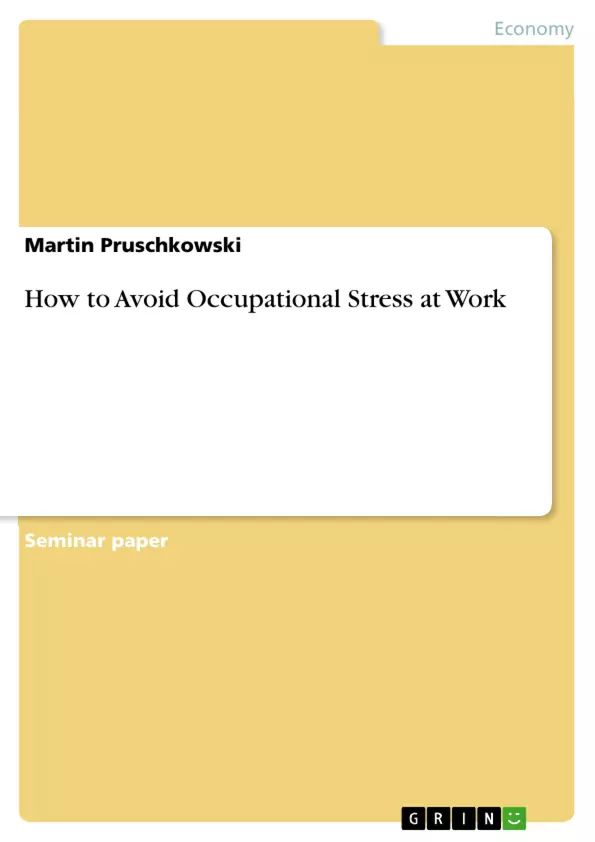In all areas of life we are surrounded today by stress, which is why people feel constantly stressed. Especially at work we are tending more and more to be stressed because of deadlines, hectic, constant accessibility and modern communication. Stress at work affects not only the health and quality of life of individuals but also harms businesses and the entire economy. The medical costs for mental diseases have been increased dramatically in the last five years.
There are various models such as the “Stress and Strain-Modell” from Rohmert and Rutenfranz, the “Job-Demand-Control-Model” from Karasek or the “Transactional Stress Model” from Lazarus & Folkman, all trying to explain what is stress and how it can be combated. What all models have in common is the fact that is always assumed an imbalance between requirements and available resources to cope the situation. As already mentioned occupational stress is the largest stress factor in Germany. The reason for this is certainly the changing world of work and the variety of stressors that lurk at work for us. These can be divided into different groups. Typically a stressor does not occur by itself but in combination with other stressors at the same time. What a person can handle depends on the duration, intensity and number of stressors and other occupational exposures.
Basically there exist two different approaches to reduce workrelated stress. On the one hand there is the structural prevention that focuses on the improvement of qualification factors, work organizational factors, social factors, technical and ergonomic factors and on the other hand there is the behavioral prevention that is concentrating on the improvement of coping skills of employees. Important is to consider and address the phenomenon of stress holistically. The company Deutsche Bahn AG has recognized the signs of the times early and offers a bunch of different tools to protect their employees from stress. In the future stress will become more and more common and the public will pay more attention to this topic because the number of mental diseases will continue to rise. Therefore there has to be a focus on occupational health and safety. In the light of demographic change, it is more important to counteract growing absenteeism and early retirement. Stress, however, can never be completely avoided so the topic of occupational stress will be at the top of the political and companies’ agenda.
Inhaltsverzeichnis (Table of Contents)
- Executive Summary
- Table of Contents
- List of Abbreviations
- List of Figures
- List of Tables
- 1 Introduction
- 2 Objectives
- 3 Methodology
- 4 Stress fundaments
- 4.1 Terms and models
- 4.2 Stress as risk and opportunity
- 4.3 Stress symptoms
- 5 Occupational stress
- 5.1 Potential stressor at work
- 5.2 Stress management at work
- 5.2.1 Structural prevention
- 5.2.1.1 Qualification factors
- 5.2.1.2 Work organizational factors
- 5.2.1.3 Social factors
- 5.2.1.4 Technical and ergonomic factors
- 5.2.2 Behavioral prevention
- 5.2.1 Structural prevention
- 6 Case study DB AG
- 7 Conclusion
- 8 Outlook
Zielsetzung und Themenschwerpunkte (Objectives and Key Themes)
This assignment aims to provide a comprehensive understanding of occupational stress, including its causes, consequences, and potential preventative measures. The work will explore various models and approaches to stress management, examining the impact of stress on both individual health and organizational performance. Additionally, a case study of Deutsche Bahn AG will be presented to demonstrate real-world strategies for addressing workplace stress.
- The definition and manifestation of stress
- The impact of stress on individual health and well-being
- The role of structural and behavioral prevention in mitigating occupational stress
- The importance of promoting social support and communication in the workplace
- Examples of successful stress management initiatives within organizations.
Zusammenfassung der Kapitel (Chapter Summaries)
- Chapter 1: Introduction: This chapter provides an overview of the prevalence and impact of stress in modern society, focusing on the changing nature of work and its contribution to increased stress levels. It highlights the importance of understanding and addressing stress, especially in the workplace, given its detrimental effects on individual health and organizational performance.
- Chapter 2: Objectives: This chapter outlines the specific goals of the assignment, focusing on providing insight into the different ways to avoid occupational stress, understanding the causes of stress, and exploring various stress management approaches.
- Chapter 3: Methodology: This chapter describes the research methods employed for the assignment, emphasizing the reliance on secondary data sources. The author outlines the approach to analyzing and interpreting existing information, including literature reviews and web-based research.
- Chapter 4: Stress fundaments: This chapter delves into the fundamental understanding of stress, exploring various models and theories that attempt to explain the creation and management of stress. It discusses the dual nature of stress, acknowledging both its risks and opportunities, and examines the different levels at which stress manifests itself.
- Chapter 5: Occupational stress: This chapter focuses on the specific challenges of occupational stress, examining its causes, including various stressors prevalent in the workplace. It explores different strategies for preventing and managing workplace stress, emphasizing the importance of both structural and behavioral approaches.
- Chapter 6: Case study DB AG: This chapter presents a detailed case study of Deutsche Bahn AG, highlighting their initiatives in addressing occupational stress among their employees. The chapter examines specific programs, initiatives, and strategies implemented by the company, showcasing a real-world example of proactive stress management.
Schlüsselwörter (Keywords)
Occupational stress, stress management, structural prevention, behavioral prevention, work organization, social support, communication, job demands, control, employee well-being, Deutsche Bahn AG, mental health, work-life balance.
- Quote paper
- Martin Pruschkowski (Author), 2014, How to Avoid Occupational Stress at Work, Munich, GRIN Verlag, https://www.grin.com/document/432955



